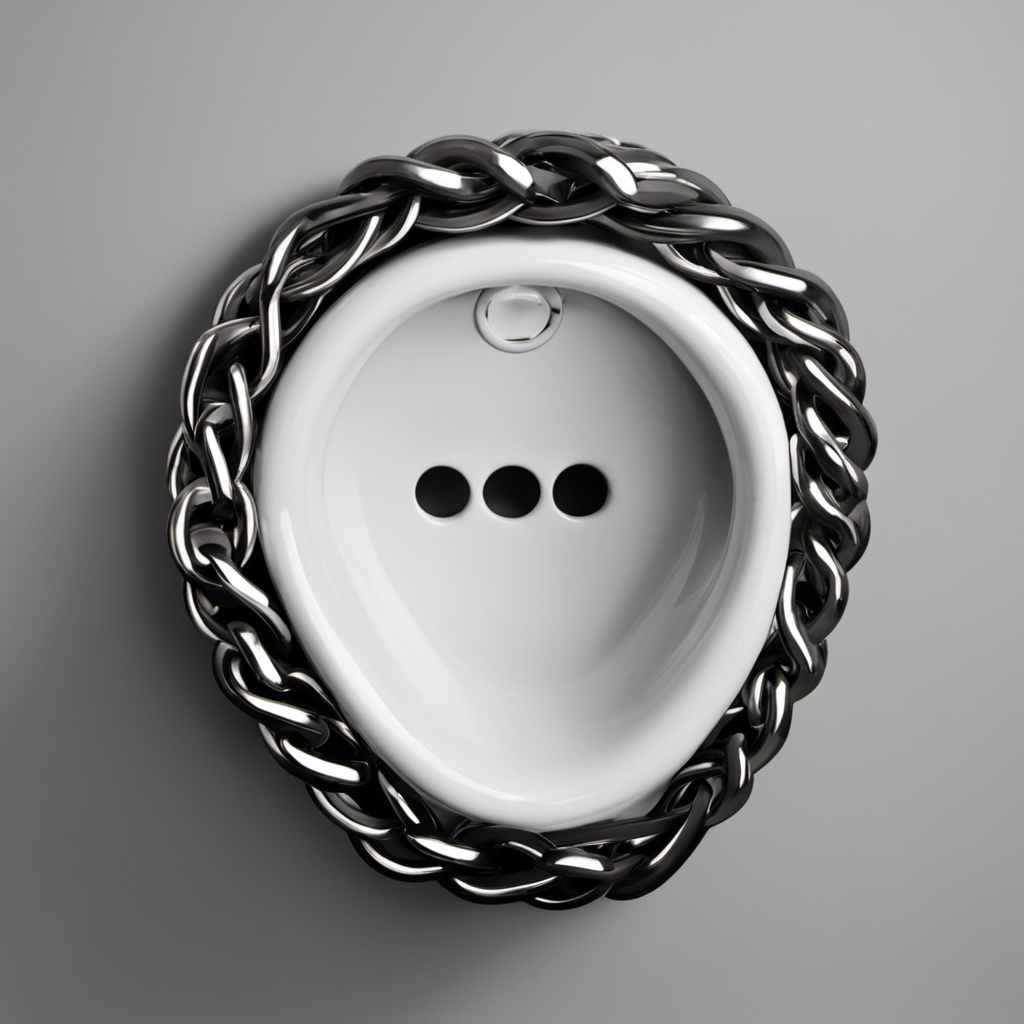I’ve been there before – the dreaded sound of a running toilet, wasting water and driving up your utility bill. But fear not, because I’m here to guide you through the process of changing your toilet flapper.
In just a few simple steps, you’ll be able to put an end to that persistent annoyance. So grab your tools, shut off the water supply, and let’s get to work.
It’s time to take control and fix that flapper once and for all.
Key Takeaways
- Regularly changing the toilet flapper prevents water leaks.
- A faulty flapper can waste up to 200 gallons of water per day.
- Water leaks can increase water bills by up to 10%.
- Changing the flapper improves toilet flushing performance.
Assessing the Flapper Problem
You should start by checking if the flapper is causing the problem. The flapper is a vital component of a toilet that controls the flow of water from the tank to the bowl. Common signs of a faulty flapper include a constantly running toilet, a weak flush, or a toilet that doesn’t flush at all.
To troubleshoot flapper issues, first, inspect the flapper for any visible signs of damage or wear. Check if the flapper is properly seated on the flush valve and if it closes tightly after each flush. You can also perform a dye test by adding a few drops of food coloring to the tank and waiting to see if it seeps into the bowl. If it does, it indicates a leaking flapper.
Once you have identified the flapper as the problem, it’s time to gather the necessary tools and materials for the replacement.
Gathering the Necessary Tools and Materials
To gather the necessary tools and materials, you’ll need a pair of pliers and a replacement part. Troubleshooting common toilet flapper issues is an essential step in maintaining a properly functioning toilet. When the flapper doesn’t seal properly, it can cause water leakage and a constantly running toilet. To address this issue, it is crucial to compare different types of toilet flappers for optimal performance. Here is a table that compares five common types of toilet flappers:
| Type of Flapper | Material | Features | Benefits | Drawbacks |
|---|---|---|---|---|
| Rubber Flapper | Rubber | Flexible and durable | Good seal | Can deteriorate over time |
| Silicone Flapper | Silicone | Resistant to chemicals and water | Long-lasting | More expensive |
| Foam Flapper | Foam | Lightweight and easy to install | Water-saving | Less durable |
| Adjustable Flapper | Plastic | Adjustable to fit different toilets | Versatile | May need frequent adjustments |
| Flush Valve Flapper | Rubber | Fits specific flush valve models | Exact fit | Limited compatibility |
Shutting Off the Water Supply
When shutting off the water supply, it’s important to locate the shut-off valve near the base of the toilet. This valve controls the flow of water to the toilet tank and must be closed before attempting any repairs or replacements.
To replace the water valve, start by turning off the main water supply to the house. Then, flush the toilet to drain any remaining water from the tank.
Next, use an adjustable wrench to disconnect the water supply line from the shut-off valve. Now, carefully unscrew the old valve from the toilet tank using a pair of pliers. Once removed, install the new valve by screwing it in tightly.
Removing the Old Flapper
After shutting off the water supply, it’s important to remove the old flapper from the toilet tank. Common flapper issues include leakage, running water, and inconsistent flushing.
To troubleshoot these problems, start by lifting the toilet tank lid and locating the flapper chain. Disconnect the chain from the flush lever, ensuring it doesn’t fall back into the tank.
Next, detach the flapper ears from the overflow pipe. Gently lift the old flapper out of the tank and inspect it for any signs of damage or wear.
If the flapper is worn out or damaged, it’s time for a replacement. Removing the old flapper is a crucial step in the process of installing the new one, ensuring a smooth and efficient toilet operation.
Installing the New Flapper
First, make sure you have the new flapper ready to install in the toilet tank.
To begin the installation process, turn off the water supply to the toilet by shutting off the valve located on the wall behind the tank.
Next, remove the old flapper by disconnecting the chain from the flush lever and lifting the flapper out of the overflow tube.
Take note of the position and orientation of the old flapper as a reference for the installation of the new one.
Now, install the new flapper by aligning it properly over the flush valve opening and ensuring a snug fit.
Attach the chain to the flush lever, leaving a slight slack for optimal functionality.
Common mistakes during flapper installation include improper alignment, incorrect chain length, and forgetting to turn the water supply back on.
Troubleshooting flapper installation issues may require repositioning the flapper or adjusting the chain length.
With the new flapper installed, it’s time to move on to testing and adjusting its performance.
Testing and Adjusting the Flapper
Now that you have installed the new flapper, it’s time to test and adjust its performance.
Testing techniques are crucial to ensure the flapper functions properly and prevents any leakage. Start by filling the toilet tank with water and observe if the flapper closes tightly after flushing. If it doesn’t, adjust the chain length so that there is minimal slack.
Check for any water seepage around the flapper. If you notice any, clean the flapper seat and ensure it is free from debris. Additionally, you can apply a thin layer of petroleum jelly to create a better seal.
Troubleshooting tips include checking the water level in the tank, as an incorrect level can affect the flapper’s performance.
With these testing techniques and troubleshooting tips, you can ensure that your newly installed flapper is working efficiently.
Frequently Asked Questions
What Are Some Common Signs That Indicate a Problem With the Toilet Flapper?
When troubleshooting toilet flapper issues, common signs of a problem include a constantly running toilet, weak flush, or water leaking into the bowl. To fix the issue, consult a guide for toilet flapper repair.
Can I Use Any Type of Flapper for My Toilet or Do I Need to Buy a Specific One?
I can’t just use any flapper for my toilet. It’s important to buy a specific one for proper toilet flapper installation. There are different types of toilet flappers available, so choose wisely.
How Often Do Toilet Flappers Need to Be Replaced?
To extend the lifespan of toilet flappers, regular maintenance is key. Troubleshoot common issues by checking for debris or mineral buildup, adjusting the chain length, and ensuring proper alignment. Flappers typically need replacement every 3-5 years.
Can I Replace the Flapper Without Shutting off the Water Supply?
Sure, you can replace the flapper without shutting off the water supply. However, it’s important to note that turning off the water supply ensures a safe and hassle-free replacement process.
Are There Any Additional Steps I Need to Take if the Toilet Flapper Is Not Seating Properly?
If the toilet flapper is not seating properly, there are a few troubleshooting tips you can try before replacing it. Additional steps may include cleaning the flapper and the flush valve, adjusting the chain length, or checking for any obstructions.
Conclusion
In conclusion, changing a toilet flapper is a simple task that can be completed with just a few tools and materials.
By following the steps outlined in this article, you can easily assess the flapper problem, shut off the water supply, remove the old flapper, install the new one, and test and adjust it as needed.
Remember to take your time and be careful during the process to ensure a successful outcome.
So go ahead, fix that flapper and enjoy a properly functioning toilet in no time!










